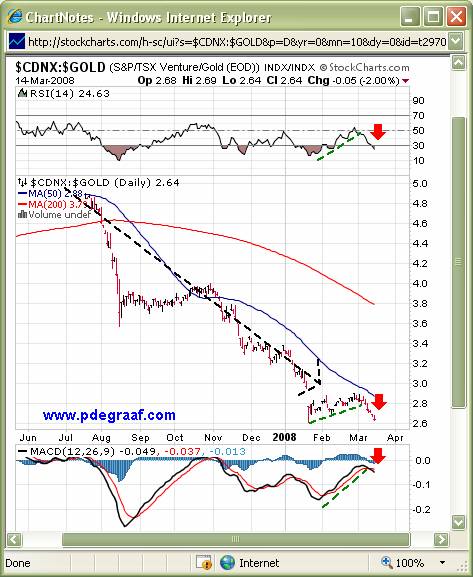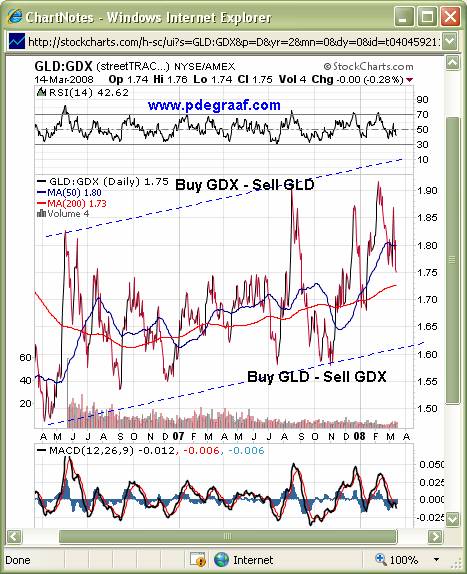Trading Gold and Silver ETF's for Profit
Commodities / Exchange Traded Funds Mar 17, 2008 - 12:10 PM GMTBy: Peter_Degraaf
 ETF's have been part of the investment scene for almost two decades. There are currently over 630 different ETF's. Recently a number of commodity ETF's have been introduced to the trading public, as more and more people are becoming interested in trading this sector, and ETF's are a simple way to participate, without having to search for specific stocks.
ETF's have been part of the investment scene for almost two decades. There are currently over 630 different ETF's. Recently a number of commodity ETF's have been introduced to the trading public, as more and more people are becoming interested in trading this sector, and ETF's are a simple way to participate, without having to search for specific stocks.
Gold, silver, oil, copper, nickel, natural gas, grains and cattle ETF's are all available, and a number of ETF's cover a mixture of similar commodities.
Commodity ETF's are a hotly debated issue, as people wonder if the assets that back the ETF, especially in the case of gold and silver, are really there, or if they are simply a commitment by a third party. For those of you who worry about that, it behooves you to read the prospectus and to contact the company that administers the ETF. Find out what auditing procedures are in place.
In view of the fact that ETF's are here to stay, it is my contention that ETF's can be very useful, especially for active traders. In the case of precious metals ETF's, my advice to those of you who trade them, is to take profits every now and then, and turn those profits into physical metal. This is the strategy I use, and it serves me very well. I try to buy the ETF's during pull-backs in price, sell them when I sense they are temporarily overpriced, and convert the profits into physical gold and silver. In any event, I do not consider a precious metals ETF to be a long term investment. For long term investment I recommend buying physical gold and silver bullion.
Almost every day I receive E-mails from subscribers, who lament the fact that some of their mining stocks are languishing, - mired as in quicksand. This next chart illustrates their dilemma.
Charts courtesy www.stockcharts.com

Featured is the chart that compares the HUI index of gold and silver stocks to the gold price. The black arrow points to the trend, which indicates that for over two years, the gold price has outperformed the gold and silver stocks that comprise the HUI index. While many explanations have been offered, including declining ore grades, a lack of large sized discoveries and the increasing cost of production, I believe the main reason for this down-trend is the “ETF effect.”
The two most popular gold and silver ETF's are the GLD and SLV. The GLD ETF has absorbed 21 billion dollars of investment capital, while SLV has 3 billion dollars invested in silver bullion. This is 24 billion dollars of capital that would very likely have gone into mining stocks, if there were no ETF's. Think of the effect 24 billion dollars invested in the mining sector would have.
While I agree with analysts who say that some mining stocks, especially junior exploration companies with proven assets (43-101 compliant), are now underpriced, nevertheless ‘ a trend in motion remains in motion until it is stopped .'
The above chart shows no signs yet of reversing. Thus, until we see a trend change, we must expect the present trend to prevail.
==================================================
Here is another chart that shows the same trend.

Featured is the chart that compares the CDNX venture index (this index keeps track of exploration companies that trade in Toronto ), to the gold price. The trend is not just down, but down sharply. The black arrow points to the longer term trend, the red arrows to the immediate trend. It is usually ‘darkest just before dawn', and thus we could soon see a reversal of this trend, but until we do, it behooves us to ‘ride the winning horses.'
I have some junior explorers in my own portfolio, and I am simply not interested in dumping them at a loss. Instead I am having fun (hence the title of this article), trading ETF's, and turning the profits of those ETF trades into bullion, while I wait for the junior explorers to awaken.
Tracking the ETF's is also a useful exercise in order to stay abreast of the trend in a particular sector, as ETF's are very ‘trend-sensitive'. People who trade agricultural commodities or who are involved in farming might find agri-ETF's useful to help them determine the ongoing trend.
Following is a partial listing, in alphabetical order, of commodity ETF's. To find out more details about a particular ETF, visit Google and type in the symbol followed by ETF, (thus “GLD ETF”).
Included in this listing are also various ETN's and Trusts, that perform similar functions and they all trade similar to stocks. (ETN's are taxed at a different rate than ETF's).
(‘TO' behind the symbol means it trades on the TSX in Toronto ).
ETF's marked ‘bear' benefit from dropping prices, similar to shorting a sector.
I also recommend that you consider visiting www.etftrends.com and register for their E-mail updates. This website is a must for ETF information.
CEF Central Gold Fund. holds 50 ozs of silver for every 1 oz of gold.
CLO.TO, Alberta Tar Sands, ETF.
COW.TO 61% live cattle, 32% lean hogs.
DBA 25% corn, 25% sugar, 25% wheat, 25% beans.
DBB 33% aluminum, 33% zinc and 33% copper.
DBC 55% energy, 23% metals, 22% agriculture.
DBO, 100% crude oil.
DCR oil bear.
DBP 80% gold, 20% silver.
DBE, 45% crude oil, 32% gas, 22% heating oil.
DBS, 100% silver.
DGL 50% gold + commodities.
DGP 100% gold, double long, based on futures. (ETN).
DGZ, gold bear (ETN).
DZZ, gold bear (ETN).
DJP 37% agricultural, 33% energy, 30% metals.
ERF energy fund
EWC Canadian banks 22%, Cdn energy 16%, Cdn materials 16%, + various Cdn stocks that trade on the TSX.
FDG/UN.TO a coal trust.
FSAGX gold fund.
GAZ, 100% natural gas
GCC 59% agricultural, 24% metals, 18% energy.
GDX, gold mining stocks, based on the GDM index.
GLD 100% gold
GSC 71% energy, 19% agriculture, 10% metals.
GSP 71% energy, 19% agriculture, 10% metals.
GTU (AMEX), GTU/UN.TO (TSX), a Gold Trust.
HBD.TO gold bear (D = down).
HBU.TO 100% gold bullion.
HGD.TO gold stocks bear (D = down).
HGU.TO 100% gold stocks.
IAU, 100% gold bullion.
IOE, tracks oil and gas exploration index.
JJA 28% beans, 23% wheat, 14% corn + bean oil, cotton, coffee and sugar.
JJC 100% copper.
JJE, 43% crude, 44% gas, 13% heating oil.
JJG 42% beans, 36% whet, 22% corn.
JJM 44% copper, 32% aluminum, 13% nickel and 11 % zinc.
JJN, 100% nickel.
KOL, this coal ETF tracks 60 companies involved in the coal industry.
MOO tracks 40 agricultural businesses, including agricultural chemicals, agri-equipment and livestock operations.
NLR, global exposure to companies involved in the uranium sector.
OIL, 100% WTI crude oil
PBW tracks stocks that are involved in alternative energy.
PCRCX 37% agricultural, 33% energy, 30% metals.
PMPIX gold fund.
PYZ follows a large cap materials stocks index.
RJA 20% wheat, 13% corn, 11% cotton + beans, bean oil, live cattle, sugar and coffee.
RJI 44% energy, 21% metals, 35% agriculture.
RJN 79% crude, 13% gas + heating oil.
RJZ 19% aluminum, 19% copper, 14% gold, 9% zinc, 9% silver, 9% lead, 8% platinum + nickel, tin and palladium.
SLV 100% silver.
TGLDX, billion dollar gold fund.
UCR, 100% oil.
UGA US gas fund.
UNG, 100% natural gas.
UNWPX gold fund.
USAGX, gold fund.
USL, 100% WTI crude oil.
USO, 100% oil.
XEG.TO Energy
XGD.TO, Canadian gold stocks that trade on the TSX.
ETF's are also useful for comparing different sectors. If you want to know if gold is outperforming gold stocks, just visit www.stockcharts.com and type GLD:GDX in the box at top right, as shown in this chart.

Featured is the chart that compares the GLD (gold bullion ETF), to the GDX (gold mining stocks ETF). While the 2 year trend favors the GLD, you can use a strategy of buying the GLD at the bottom support line, and the GDX at the top of the channel, thereby benefiting from the trend. If and when gold stocks begin to outperform bullion, you will find yourself staying longer with the GDX. This method of trading does not provide specific entry points, but it does offer a solid choice, once a decision to buy has been made.
Summary: ETF's and ETN's serve a useful purpose for active traders. They can be expected to grow in popularity. They should not take the place of your core holdings of valuable commodities.
Happy trading!
I welcome your input, in case I have missed a commodity ETF or ETN, as well as appreciate suggestions for follow-up articles on this subject.
By Peter Degraaf.
Peter Degraaf is an on-line stock trader, with 50 years of investing experience. He issues a weekly Email alert. For a 60 day free trial, send him an Email at ITISWELL@COGECO.CA , or visit his website: WWW.PDEGRAAF.COM
DISCLAIMER: Please do your own due diligence. I am NOT responsible for your trading decisions.
Peter Degraaf Archive |
© 2005-2022 http://www.MarketOracle.co.uk - The Market Oracle is a FREE Daily Financial Markets Analysis & Forecasting online publication.



